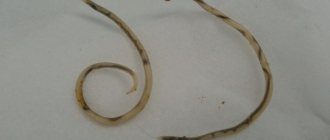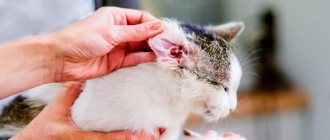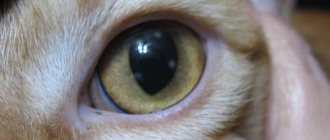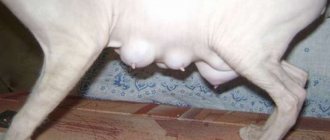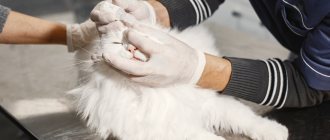Scabies is caused by itch mites - Demodex, Sarcoptes, Notoedrus and Otodectes. The disease is promoted by unsatisfactory housing and feeding conditions, as well as infectious or invasive pathologies that weaken the immune system.
Sarcoptes is dangerous to humans. This parasite causes scabies, which can be contracted from a cat.
What to do in such a situation? To get started, we recommend reading this article. This article describes in detail methods of controlling parasites. We also recommend that you consult a specialist. Read the article >>>
Causes of mange in cats
The cause of the disease is the active activity of the Notoedres cati tick. These parasites can cause the most severe infectious skin diseases. They live in the lower layers of the dermis, feeding on skin particles and lymph. This is where they lay their eggs. In one day, 1 female tick is capable of laying from 2 to 8 eggs, and in her entire life - about 20 eggs.
Ticks have a spherical shape, the color of the body is gray. The length of the parasite is about 0.14-0.45 mm. It has small suction cups on its paws, which it uses to cling to the animal.
Scabies mites in cats may not always cause the development of the disease. The most susceptible to this are:
- emaciated animals;
- cats with reduced immunity;
- young animals;
- have not undergone special antiparasitic treatment.
Most often, scabies is only a secondary disease. Therefore, its appearance may indicate the presence of more severe disorders in the cat’s body.
Methods of infection
The main route of infection is contact. Outside the host, the tick can live for a very short time; all processes of feeding, growth and reproduction take place only in the skin of the animal. However, notoedres cati is highly contagious between cats. If someone in a group of animals develops this disease, it is highly likely that all of them will soon become infected. In the environment, a tick can live up to a week and still remain infectious. That is, even cats that live only in an apartment without access to the street have a small chance of becoming infected with a tick that the owners brought from a walk on clothes or shoes.
Since the body’s own immunity also plays a role in the development of clinical symptoms, it is quite rare to see notoedrosis in street cats. However, such cats can be hidden carriers, meaning that they themselves do not get sick, but can infect others - for example, your pet cats.
Symptoms
The owner of the animal can recognize the unpleasant disease on his own. Signs of scabies in a cat are as follows:
- Severe itching. This is the main symptom of the disease. First, the cat feels itching in the ears and neck. Discomfort occurs as a result of the fact that the tick digs its way into the thickness of the skin, where it subsequently lays eggs. Because of this, the cat begins to shake its head, trying to shake off the parasite, scratches constantly, becomes restless, can be aggressive and stops eating. PHOTO
- Scratches and scratches occur due to frequent scratching, which can sometimes be obsessive. PHOTO
- Hair falls out in the affected areas, and dark crusts are clearly visible on the surface of the skin. First, hair loss begins at the edges of the ears, gradually the problem moves to the forehead and neck. If treatment is not started in time, hair loss can be general and affect the entire body of the animal. PHOTO
- At the place where the tick pierced the skin, there is a hard bump with a diameter of up to 10 mm. A small hole is visible at its top. If you press on the tubercle, a white thick liquid will be released from the hole. The skin around the lump is red and scaly. PHOTO
- Nodules may appear on the skin, which subsequently fester. PHOTO
Modern approaches to the diagnosis and treatment of scabies
Scabies is a contagious parasitic skin disease caused by the scabies mite Sarcoptes scabiei, accompanied by itching, worse in the evening and at night, and papular-vesicular rashes.
Currently, scabies remains one of the most common parasitic dermatoses in our country.
An increase in the number of patients with scabies usually accompanies wars, natural disasters, and social upheavals, which is caused by population migration, economic recession, and deterioration of social and living conditions.
As mentioned above, the causative agent of scabies is the scabies mite - Sarcoptes scabiei. This species belongs to the family Sarcoptidae, group Acaridiae, suborder Sarcoptiphormes, order Acariphormes. Members of the genus Sarcoptes are currently known as parasites of more than 40 species of animal hosts belonging to 17 families of 7 orders of mammals.
The morphological appearance of scabies mites of the Sarcoptidae family is extremely unique and is due to profound adaptations to intradermal parasitism. The structure of scabies, like most mites, is characterized by strict constancy of the microstructures of the exoskeleton, which is associated with their microscopic size.
The female scabies mite resembles a turtle in appearance. Its size is 0.25–0.35 mm. Adaptations for intradermal parasitism are represented by multiple setae, triangular outgrowths of the cuticle on the dorsal surface, spines on all tarsi that serve as stops when gnawing, gnawing-type chelicerae, long elastic bristles on the tarsi of the hind pairs of legs to maintain the direction of the gait only forward. Adaptations for ectoparasitism are sticky pneumatic suckers on the front legs, waxy bristles on the body and limbs, which create an extensive mechanoreceptive sphere around the tick and allow it to navigate by touch without eyes. The speed of movement of the female during the course is 0.5–2.5 mm/day, and on the surface of the skin 2–3 cm/min. Scabies mites are characterized by sexual dimorphism. The main function of males is fertilization. They are much smaller in size - 0.15–0.2 mm, have dense bristles on the body for protection from mechanical stress and suckers also on the fourth pair of legs for attachment to the female during mating. The ratio of females to males in scabies mites is 2:1.
The life cycle of the scabies mite is clearly divided into two parts: short-term cutaneous and long-term intradermal. Intradermal is represented by two topically separated periods: reproductive and metamorphic. Reproduction is carried out by the female in the itch she gnaws, where she lays eggs. The hatching larvae emerge from the passages onto the surface of the skin through holes made by the female above the site of each clutch, settle on it and penetrate into the hair follicles and under the scales of the epidermis. Here their metamorphosis (molting) occurs: through the proto- and teleonymph stage, new individuals (females and males) are formed. Females and males of the new generation come to the surface of the skin, where they mate. Daughter females migrate to the hands, wrists, feet, penetrate the skin and immediately begin to make passages and lay eggs. In rare cases, the introduction of females is possible in other areas of the skin (buttocks, axillary areas, abdomen, etc.) due to mechanical pressure. Clinically, this corresponds to scabious lymphoplasia of the skin. Only females and larvae are infective stages and participate in infection. At room temperature and relative humidity, at least 60% of females retain mobility for 1–6 days. Even at 100% humidity, females survive on average up to 3 days, larvae - up to 2 days.
Scabies mites are characterized by a strict daily rhythm of activity. During the day, the female is at rest. In the evening and in the first half of the night, she gnaws one or two egg knees at an angle to the main direction of the stroke, in each of which she lays an egg. Before laying eggs, she deepens the bottom of the passage, and makes an exit hole in the roof for the larvae. During the second half of the night, the female gnaws the passage in a straight line, feeding intensively; during the day, she stops and freezes. The daily program is carried out by all females synchronously. As a result, the itch on the patient's skin has a convoluted shape and consists of segments of the course, called the daily element of the course. The posterior part of the tract gradually peels off, and during a clinical examination of the patient, it simultaneously consists of 4–7 daily elements and has a constant length of 5–7 mm. During her life, the female travels 3–6 cm in the epidermis; the revealed daily rhythm of activity is of great practical importance. It explains the intensification of itching in the evening, the predominance of the direct route of infection through contact in bed in the evening and at night, and the effectiveness of prescribing anti-scabies at night.
Clinical picture
The clinical picture of scabies is determined by the characteristics of the pathogen and the reaction of the host body to its introduction.
The incubation period for scabies varies in length and depends on whether the skin is an adult female or a larva. In the first case it is extremely short, and in the second it is 2 weeks. Itching, as the main symptom of scabies, appears in a period that ranges from 14 days to 6 weeks during primary infection and can be extremely short, limited to a few days during reinfection. It has also been shown that reinfection, however, may be more difficult in already sensitized individuals, and the number of detectable scabies mites in such patients is often minimal [7, 9].
The typical form of scabies is characterized by the presence of itchy skin, which is most pronounced in the evening and during sleep. However, the itching can also be constant. It can be localized to individual areas of the skin or spread throughout the body, with the exception of the facial skin and scalp. An extremely important sign is the presence of itching among family or team members.
During the examination, specific rashes are revealed. The main clinical symptoms of scabies are scabies, polymorphic rashes outside the tracts, characteristic sites of rashes, as well as symptoms named after the authors Ardi (presence of pustules and purulent crusts on the elbows and in their circumference), Gorchakov (presence of bloody crusts there), Michaelis (presence of bloody crusts and impetiginous rashes in the intergluteal fold with transition to the sacrum), Sezari (detection of scabies in the form of a slight elevation on palpation).
Typical localization sites for rashes are predominantly the flexor surface of the joints (wrist and elbow), as well as the anterolateral surface of the abdomen, lower back, buttocks, and genital area, while they are absent on the upper half of the back. Scabies and rashes are well expressed in the interdigital and axillary folds, on the areola of the breast of women, in the navel area. The rashes are represented by paired papules and vesicles, scabies, eczematous pseudovesicles (pearly vesicles) on the skin of the lateral surfaces of the fingers and palms; scabious ulcers, with crusts on the surface; as well as scabious nodules.
It seems to us advisable to classify and present atypical forms of scabies
- scabies without skin lesions;
- urticarial scabies;
- scabies during corticosteroid therapy;
- nodular (with postscabiosis nodules) scabies;
- eczematized scabies;
- scabies complicated by pyoderma;
- Norwegian scabies;
- infant and childhood scabies.
The first two forms are caused primarily by allergic reactions.
Scabies without skin lesions can represent the beginning forms of the disease in people who observe standards of body hygiene, but more often it manifests itself as an allergic reaction to mite antigens during the period of the disease or after its treatment. This form of the disease is more often detected during an active examination of persons who have been in contact with a patient with scabies.
Urticarial scabies is represented by small blisters caused by sensitization to both mites and their metabolic products. They occur more often on the front of the torso, thighs, buttocks and forearms.
Scabies with local corticosteroid therapy, also called latent scabies, as a result of suppression of the immune reactions of the skin, leads to the loss of specific symptoms of scabies. The disease acquires papulosquamous, papulovesicular, and sometimes even hyperkeratotic rashes.
Nodular scabies (scabious lymphoplasia) is characterized by the appearance of itchy nodules that are red, pink or brown. Scabies can be found on the surface of new nodules. Typical localization: penis, scrotum, axillary and intergluteal folds, areola. The nodules are usually few in number. Sometimes they are the only diagnostic sign of scabies [2, 4].
Eczematized scabies usually occurs in people with an allergic predisposition. Foci of lichenification may appear at the sites of scratching. However, eczematous lesions usually come to the fore and the diagnosis of scabies may not always be suspected. Rashes appear on the hands, armpits, legs, and hands. In advanced cases, the rash can become disseminated, leading to the development of erythroderma.
In persons with reduced body resistance, eczematized lesions at the sites of scratching may be accompanied by a secondary bacterial infection in the form of impetigo or ecthyma; staphylococcal folliculitis, boils and abscesses may occur.
Norwegian scabies (crustic, crusted) in the initial stages is presented as ordinary scabies or disguised as atopic dermatitis, psoriasis, seborrheic dermatitis. Characterized by keratinization, the formation of scales or thick crusts. In case of severe immunodeficiency, the process can be generalized; in case of neurological diseases, it can manifest itself in a limited area of sensory impairment.
Infant and childhood scabies are characterized by rashes resembling urticaria or infant pruritus in the form of a large number of scratched and crusty blisters with a predominant localization in the perineum on the scrotum, in the axillary folds. Characteristic scabies can be found on the soles.
Diagnostics
Diagnosis of scabies, in addition to clinical data, is based on microscopic confirmation of the diagnosis. However, this procedure requires considerable skill, an experienced microbiologist, and is not feasible in some clinical forms. The minimal clinical manifestations of scabies also make it difficult to obtain sufficient biological material for research. The technique has advantages in specialized institutions. There are several methods for laboratory diagnosis of scabies: removing the mite with a needle, the method of thin sections, scrapings, alkaline skin preparation.
Treatment
For the treatment of scabies, various preparations of sulfur, benzyl benzoate, Peruvian balsam, etc. were previously proposed. In recent years, new drugs have begun to be used, such as Spregal, crotamiton, lindane, malathion, permethrin, Prioderm, Tetmosol, thiobendazole, prescribed in the form of ointments, creams, solutions , shampoos, emulsions and aerosols. The main requirements for anti-scabies are the speed and reliability of the therapeutic effect, the absence of irritating effects on the skin and contraindications for use, ease of preparation and use, stability during long-term storage, availability for mass use, hygiene and low cost [8, 9] . In addition, various forms of scabies, such as postscabiosis, eczematized or urticarial, require the addition of pathogenetic therapy.
General principles: rubbing anti-scab preparations into the skin, especially carefully into the mite’s favorite localization areas. After each forced hand washing, it is necessary to re-treat them with an anti-scabies agent. In the presence of complications (primarily pustular skin lesions), lubrication rather than rubbing is performed. Before starting treatment, it is advisable to take a hot shower or bath, using a washcloth and soap to mechanically remove mites from the surface of the skin, as well as to loosen the surface layer of the epidermis, which simplifies the penetration of antiscabiotic drugs. In the presence of secondary pyoderma, water procedures are contraindicated. Regardless of the method of therapy, the entire skin is treated with an anti-scabies drug. Avoid contact of the drug with the eyes and mucous membranes. The dosage of the acaricidal agent should not be too large, and other skin preparations should not be used at the same time. The patient should be given clear and precise recommendations.
Medicines used to treat scabies:
1. Preparations containing sulfur
It has long been used to treat scabies. Examples of such products are: 10–33% sulfur ointment, 10% sulfur vaseline, Demyanovich’s method, Wilkinson ointment, 5–10% polysulfide liniment, Sulfodecortem, Helmerica ointment, Milian paste.
Currently, the use of such drugs is limited, since the therapeutic effect of some of them is questioned. In addition, they have a number of undesirable properties: medications have an unpleasant odor, stain clothes and underwear, and have an adverse effect on the skin (dermatitis, eczematization).
Sulfur ointment - a 33% concentration is used to treat adults, and 10–15% to treat children. The ointment is rubbed daily, preferably at night, over the entire skin for 5–7 days. On the 6th or 8th day, the patient washes, changes his underwear and bed linen.
Sulfodecortem is a drug containing 10% precipitated sulfur and hydrocortisone acetate. Apply after washing for 5–7 days. Repeated washing and change of linen are carried out after the end of the course of treatment.
The Demyanovich method was widely used in our country. It is based on the acaricidal effect of sulfur and sulfur dioxide, released during the interaction of sodium thiosulfate and hydrochloric acid.
A 60% solution of sodium thiosulfate (solution No. 1) and a 6% solution of concentrated hydrochloric acid (solution No. 2) are successively rubbed into the skin of the torso and limbs; for children, the concentration is 40% (No. 1) and 4% (No. 2). Apply solutions for 3 days. Before use, solution No. 1 is slightly warmed up and rubbed into the skin with your hands in a certain sequence: starting with simultaneous rubbing of the drug into the skin of both hands, then the limbs, then the skin of the torso (chest, abdomen, back, gluteal region, genitals) and finally skin of the lower extremities to the toes and soles. Rubbing into each area lasts 2 minutes, the entire procedure should take at least 10 minutes. The second rubbing is carried out with the same solution in the same way as the first. After a 10-minute break, they begin to rub in solution No. 2 in the same sequence, 1 minute for each area 3-4 times with 5-minute breaks for drying. At the end of rubbing and after the skin has dried, the patient puts on clean underwear and does not wash for 3 days, but rubs it into the hands again after each wash. After 3 days, the patient washes and changes his underwear again.
Solution No. 1 Rp.: Natrii thiosulfatis 120.0 Aq. Destil. Rub 80.0 M.DS into the skin Solution No. 2 Rp.: Ac.hidrochlorici puri 12.0 Aq. Destil. 200.0 MDS rub into skin
Today, the use of this drug is limited due to the ever-decreasing number of pharmacies that have production departments. In addition, this method is very labor-intensive and is accompanied by the release of an unpleasant odor of sulfur and sulfur dioxide.
2. Peruvian balsam
This balm is made from an extract of one of the plants of the legume family (Miroxylon Periferum). One of the active ingredients is cinnamein, which contains benzyl benzoate, which apparently gives the drug an antiparasitic effect. Side effects include local allergic reactions and eczema. When applying the drug to a large surface area of the body, resorptive effects with symptoms of renal intoxication are possible.
3. Benzyl benzoate preparations
Benzyl benzoate. It is used in the form of a 20% water-soap suspension; children under 3 years of age are prescribed a 10% suspension. The suspension is rubbed into the skin of the entire body, except the head, and for children under 3 years old and into the skin of the face. Rubbing is carried out in a certain sequence (see Demyanovich's method). The course requires two treatments with an interval of 3 days to affect the mobile forms of the mite and larvae. Linen is changed twice after each treatment. The cost of the drug is 100 ml for treatment and 200 ml for the course. Treatment with benzyl benzoate is contraindicated in pregnant women and during lactation. The freshly prepared drug is most effective. When stored, benzyl benzoate loses its effectiveness, which explains the failures in its use.
It is also possible to use benzyl benzoate in the form of a 10–20% ointment. In this case, the consumption of the drug is 30–40 g per application and 60–80 g per course.
Askabiol is a drug containing equal amounts of benzyl benzoate, solid soap and ethyl alcohol.
Benzoseptol is a preparation containing equal amounts of benzyl benzoate, mild soap and isopropyl alcohol.
Novoscabiol is a drug containing benzyl benzoate - 30.0, methyl ester - 1.0, paraffin oil - 69.0.
Nbin is a preparation containing benzyl benzoate - 68 parts, Tween-80-14 parts, anesthesin - 12 parts, DDT (insecticide - trichloromethyldi(p-chlorophenyl)methane)) - 6 parts.
4. Lindane or gammabenzenehexachlorane
This organochlorine insecticide is used in the form of a 1% lotion, which is applied once to the entire surface of the body and left for 6 hours, then washed off. In hot climates, it is possible to use lindane in powder form. The drug can also be used in the form of cream, shampoo and ointment. The drug is not used during pregnancy and lactation, in infancy, as well as in patients with eczema and atopic dermatitis, as it can cause exacerbation (Latin exacerbo - irritate, aggravate) the process.
5. Crotamiton (Yurax)
Apply as 10% cream, lotion or ointment. The active ingredient crotamiton, in addition to its acaricidal effect, has the ability to relieve itching, which is very important for patients with scabies. Apply the drug after washing 2 times a day at daily intervals or four times every 12 hours for 2 days. The drug is interesting because it does not cause side effects and can be used to treat children, pregnant women and patients with allergic dermatoses. At the same time, its effectiveness is not absolute.
6. Permethrin preparations
The mechanism of action is based on disruption of the permeability of membranes of insect nerve cells to cations, which has an acaricidal effect. Affects adult larvae and eggs.
Medifox is a 5% concentrate of the synthetic pyrethroid permethrin in alcohol and castor oil. Available in ampoules of 2 ml, glass bottles of 24 ml, polymer containers from 0.1 to 5.0 l. It is applied externally in the form of a freshly prepared 0.4% emulsion. To do this, 8 ml of a factory-packaged 5% solution should be added to 100 ml of water. Rubbing is done once a day at night for 3 days. Shelf life of the working emulsion is 8 hours.
Nittifor is a solution for external use in a 60 ml bottle, containing permethrin and cytylperidinium bromide.
Rubbing the drug is carried out once a day at night for 3 days. On the fourth day, the remnants of the drug are washed off with cold water and bed and underwear are changed.
7. Pyrethrin group
Aerosol Spregal (esdepalletrin) is a synthetic pyrethrin (neurotoxin for small arthropod parasites), enhanced with piperonyl butoxide (an enzyme inhibitor that helps remove pyrethrin from the parasite), used as the active principle of the aerosol anti-scabies Spregal. An excipient (auxiliary substance) specially developed for it allows the solution to be applied to the entire surface of the skin and ensures the penetration of the active substances into the skin and scabies tracts with the subsequent destruction of the female mite and her eggs.
However, when using Spregal, some caution is sometimes required, for example, in the presence of a large number of excoriations, since in this case there may be a slight increase in skin itching and the appearance of dermatitis in patients who have an individual intolerance to one of the components.
The question of choosing a drug for the treatment of scabies is the main one for the practitioner.
The choice of therapeutic method for atypical forms of scabies is based on modern knowledge of its immunopathogenesis. Adding differentiated pathogenetic therapy to basic etiotropic therapy increases the effectiveness of treatment of these forms of scabies that are difficult to treat.
A special problem in the treatment of scabies is severe itching that does not disappear after treatment. The reasons for this phenomenon can be varied:
- allergy to the used medicinal drug, especially in suspicious patients who use it too often;
- a state of physiological hypersensitivity, which manifests itself in the fact that severe itching does not disappear within 8–10 days after treatment;
- incorrect diagnosis;
- improper treatment or secondary invasion;
- psychiatric problems: acarophobia (fear of scabies) or mania for parasitosis.
Thus, persistent itching can be due to various reasons and requires medical supervision; the patient should not self-medicate.
Prevention of scabies
The most important link in the prevention of scabies is early diagnosis and active identification of patients. They are carried out during preventive examinations of designated groups of patients. It is very important to identify foci of scabies and work to eliminate them. Identification and simultaneous treatment of all contact persons. Timely and thorough disinfection of clothing, underwear and bed linen. Control of cure is carried out 3 days after the end of treatment, and then every 10 days for 1.5 months. Linen is boiled, dresses and other clothes (if it is impossible to process in a disinfection chamber) are thoroughly ironed or ventilated in the air for 5 days, and in the cold for 1 day. Conducts wet cleaning with a 5% chloramine solution. Upholstered furniture is treated with the same solution. For the purpose of disinfecting an epidemiological outbreak, an aerosol agent A-PAR is recommended, which allows for high-quality disinfection at home.
A-PAR is an anti-itch preparation, the excipient of which, safe for humans, allows you to disinfect clothing and bedding without leaving stains on clothing and, in addition, is intended for treating furniture, hard surfaces, door handles, children's toys, and shoes.
Final disinfection is carried out after the end of treatment, in children's groups twice: after identifying a patient in the group and at the end of treatment. In large, long-term, intensively operating teams, it is advisable to carry out final treatment of premises using the preparations Medifox (0.2% aqueous emulsion), Medifox-super (0.2% aqueous emulsion), Tsifox (0.5% aqueous emulsion).
Literature
- Gebra F. Guide to the study of skin diseases: trans. with him. Ed. A. A. Polotebny. St. Petersburg: O. I. Bakst, 1876. T. 1.
- Daria J. Fundamentals of dermatology: trans. from French Ed. A. A. Sakhnovskaya. M.–L.: State. publishing house, 1930.
- Demyanovich M. P. Scabies. M.: Medgiz, 1947.
- Korotky N. G. Modern external therapy of dermatoses. Tver: Provincial Medicine, 2001.
- Savchak V., Galnikina S. Practical dermatology. K.: Ukrmedkniga, 1998. pp. 14–22.
- Samtsov A.V. Contagious dermatoses and venereal diseases (modern methods of treatment). St. Petersburg: Special literature, 1997. pp. 30–33.
- Sergeev Yu. V. Modern clinical and immunological features of scabies and new approaches to its diagnosis and therapy // Immunopathology, allergology, infectology. 2000, No. 4, p. 102–107.
- Sokolova T.V., Fedorovskaya R.F., Lange A.B. Scabies. M.: Medicine, 1989.
- Sokolova T.V., Lopatina Yu.V. Parasitic dermatoses: scabies and mite-borne dermatitis. M.: Binom, 2003.
- Fedorov S. M., Selissky T. D. Scabies. In the book: Skin diseases. M.: Medicine, 1998. pp. 164–172.
- Belyab P., Jean-Pastor M. J. Scabies. SCAT. 1996, Marseille. R. 22–26.
- Ackerman B. Histopathology of human scabies. Ed. Lippincott Compagny, 1997, Philadelphia. R. 88–95.
- Saurat JA Risques systemiques des medicaments topiques chez l'enfant // Sem. Hop. Paris. 1982, 58, 26–27, 1643–1649.
- Shakter B. Treatment of scabies and pediculosis with linden preparation: an evalution // J. Am. Acad. Dermatol. 1981, 5, 517–527.
- Van Neste D. Immuno — allergological aspects of scabies: a comparative study of spontaneous blastogenesis in the dermal infiltrates of common and hyperkeratotic scabies? Allergic contact dermatitis and irritant dermatitis // Arh. Dermatol. Res. 1982, 274, 159–167.
I. V. Verkhoglyad, Doctor of Medical Sciences, Associate Professor I. Ya. Pinson, Doctor of Medical Sciences
GBOU DPO RMAPO Ministry of Health and Social Development of Russia, Moscow
Contact information for authors for correspondence
Diagnostics
Scabies in a cat brings severe discomfort to the animal's life. Also, a sick animal can cause illness to other pets in the house and people who come into contact with it. The cat needs to be shown to a specialist and treatment started on time. A full diagnosis should be carried out to exclude other skin diseases (for example, lichen or dermatitis).
In most cases, an external examination of the cat and a medical history is sufficient for the veterinarian to make a diagnosis. But to determine the type of mite and draw up an optimal treatment regimen, you need to scrape the deep layers of the skin.
Prevention
The best preventive measure is the regular use of antiparasitic drugs, in cats this is usually drops on the withers. If you pick up a stray cat on the street, you need to show it to a doctor before bringing it home. If there are already cats at home, it is recommended to isolate them from the new resident for a period of quarantine, observation and, if necessary, treatment. Typically, domestic cats are left in their usual quarters, and the new pet is given a separate small room.
Treatment of scabies in cats
Treatment of scabies should begin with isolating the animal. This will help prevent family members and other animals from becoming infected. After this, use the medicine prescribed by your doctor. It can be in the form of injections, drops or ointment.
Additionally, the owner can alleviate the animal’s condition by washing away dead epidermis, fallen hair, and crusts of dried blood. This should be done as carefully as possible and in protective clothing.
Scabies injections
Only special scabies injections can eliminate mites that are located deep in the skin. For the treatment of cats the following are prescribed:
- Ivermectin. The drug has a broad antiparasitic effect; its use leads to paralysis and then death of ticks. Careful dosage is required as the composition is toxic to cats. PHOTO
- Baymek. It has a long-term antiparasitic effect and disrupts the nervous system of parasites. It is administered subcutaneously, and it is recommended to distribute the required amount of the product into several injections, which must be given in different places. PHOTO
- Novomek. The active ingredient is ivermectin. It has a systemic and contact effect on ticks, affects the release of gamma-aminobutyric acid, which provokes a block in the transmission of nerve impulses, resulting in tick paralysis. The product is non-toxic and harmless to cats, provided the dosage is followed. PHOTO
The dangers of ignoring the disease
Without treatment, your cat will not get rid of mange. The disease can only be aggravated by the addition of a bacterial infection. Microorganisms enter through skin damaged by scratching, causing pustules and large wounds.
A mite that has settled in the ear can cause inflammation of the eardrum, middle and inner ear. As a result, the cat faces deafness, and in the most severe cases, death.
Drops for scabies
Tick drops are only an additional treatment method. Treatment of cats should be comprehensive with the use of injectable antibiotics. The following are used as external agents:
- Neostomazan - affects the central and peripheral nervous system of arthropods, has a prolonged effect, can be used to wet or bathe the animal, for which the drug is diluted in water (the recommended doses will be advised by the veterinarian), the treatment of the animal is repeated after 10 days;
- Amitrazine is a drug with an acaricidal effect, it is active against the larvae and sub-adult phases of parasite development, the death of the latter is possible due to disruption of their motor activity and paralysis;
- Butox is a broad-spectrum drug, has an oily structure, dissolves well in water, is active against various types of mites, including scabies, and can accumulate in the body (in the ganglia of peripheral nerves) of arthropods, which inhibits their motor activity, and can used for spraying or bathing the animal.
Diagnosis and treatment
To accurately determine the type of tick, a specialist must scrape it and send it for analysis. This is done in order to exclude diseases with similar symptoms - eczema, allergies, dermatitis or lichen. Drug therapy for a four-legged patient lasts on average from one to three weeks. Special shampoos, sprays, ointments, as well as oral medications of various forms (drops, syrups, tablets) are used as treatment. The approximate treatment formula looks like this:
- treating the affected surface with a gentle antiseptic - hydrogen peroxide, miramistin, chlorhexidine;
- taking antibiotics to prevent the risk of developing a secondary infection;
- use of acaricides to control insects;
- taking antihistamines to relieve itching;
- stimulating the work of immune cells with the help of vitamin complexes.
Particular attention should be paid to antiparasitic treatment. The dosage and drug should be determined by the doctor, taking into account the health characteristics of a particular animal. The effectiveness of the prescribed therapy will depend on the accuracy of the procedures recommended by the specialist. Even skipping a medication once will delay the healing process indefinitely.
Ointment for scabies
Elimination of symptoms and treatment at home is possible. The following are used as local therapy:
- Ointments and lotions based on tar or sulfur.
- Sea buckthorn oil.
- Pikhtoin. Has a complex anti-inflammatory effect. After application, the product penetrates through the glands and partially into the intercellular passages, then becomes soluble and is absorbed by the body. Apply a thin layer, after which it is recommended to apply a gauze bandage.
- Avermectin paste is rubbed against the grain in places where insects accumulate and on the back of the head. For ease of use, it can be melted. The procedure must be repeated after 7-10 days, but if the affected area of the animal is large, then the frequency of application of the product is increased.
These products help eliminate skin inflammation and restore its protective functions. But they must be used with extreme caution, since there is a high risk of the product getting inside, which can lead to intoxication. Therefore, it is recommended to purchase and constantly use a special cone-shaped collar. It will prevent the product from being licked off.
Treatment of notohedrosis
Before using medications, it is necessary to remove hair from the outer part of the ears in the affected area. The second step is to bathe the cat with shampoo that contains acaricidal components. In the early stages, you can treat your pet with local remedies. Aversectin or novertine ointment is suitable for this; they are applied twice a week. An alternative may be Demos gel, the frequency of its use is once every four days.
global $ads_google; //data-ad-slot=”2475549904″ $ads_google = empty($ads_google) ? false : true; ?> if ($ads_google == false) {?>
$ads_google = true; ?> } ?>
For systemic treatment of feline scabies, injections of drugs based on ivermectin (1%) are prescribed - five injections every five days. The therapy includes Stronghold drops with selamectin or Advocate, they are used every three weeks.
Can you get scabies from a cat?
The question of whether it is possible to become infected from an animal haunts many owners. Scabies can be transmitted from a cat to a person through contact with a sick animal. The causative agents of the disease cause a red rash on the host's skin, which is similar to mosquito bites. The mite can infect the skin of the legs, arms, thighs, chest, and abdomen.
In this case, there cannot be a strong infection due to the inferiority of the life cycle of mites without the original host, but the resulting irritation on the skin can be extremely unpleasant. The itching goes away only within 2-3 weeks after complete isolation of the animal. Additionally, you can consult a doctor to prescribe a drug to eliminate unpleasant symptoms.
Is scabies contagious to humans?
The question of whether scabies is transmitted to humans or not worries every owner of a fluffy cat. The disease is considered contagious and can spread to other animals and humans. These parasites cannot live outside a living organism; they definitely need a host. However, scabies mites, having penetrated the epidermis of human skin, cannot exist in it for a long time. Symptoms of infection with sarcoptic mange or notoedrosis look like an allergy. In rare cases, otodectosis can cause otitis externa.
global $ads_google; //data-ad-slot=”2475549904″ $ads_google = empty($ads_google) ? false : true; ?> if ($ads_google == false) {?>
$ads_google = true; ?> } ?>
Human skin is too dense for scabies mites; they cannot lay eggs in it or move around. This feature saves a person from cat scabies. In the short period while the ectoparasite is in the upper layers of the dermis, it causes itching and discomfort. After spontaneous healing, the symptoms disappear. Despite these features, when treating a sick cat, the owner must observe personal hygiene measures:
- use gloves when handling your pet;
- wash your hands with soap after treatment procedures;
- boil things that the cat has come into contact with;
- Regularly vacuum carpets and wash floors in the house.
Scabies mites disappear from the human body in less than a month.
Preventive measures
Scabies in cats can be prevented by regularly examining the animal yourself or taking it to the veterinarian once every 3 months. There are other preventive measures that will help avoid the disease:
- do not let the cat out of the apartment;
- if the animal cannot live without walks, then regularly use special products against fleas, ticks and worms;
- include vitamins in the cat’s diet if the animal does not eat special food;
- strengthen immunity;
- wash your cat's dishes thoroughly;
- follow the rules of caring for your pet, regularly bathe the animal using special shampoos, even if it does not go outside, because fleas and ticks can be carried into a person’s house on shoes and clothes.
If the cat has already been diagnosed with this disease, then in order to prevent relapse, injections of Immunoparasitan are recommended every 3-6 months. The action of this drug allows you to increase the body’s protective functions and prevent re-infection.
All information posted on the site is provided in accordance with the User Agreement and is not a direct instruction to action. We strongly recommend that before using any product, you must obtain a face-to-face consultation at an accredited veterinary clinic.


